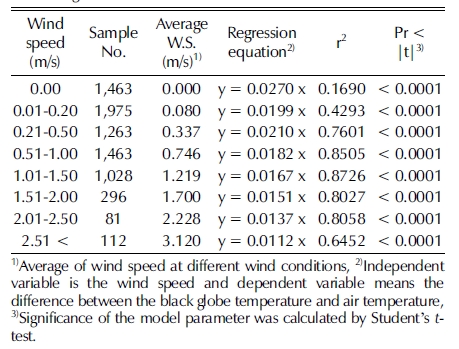
흑구온도를 이용한 천궁 엽온 예측 모델 개발
© The Korean Society of Medicinal Crop Science. All rights reserved.
This is an Open-Access article distributed under the terms of the Creative Commons Attribution Non-Commercial License ( http://creativecommons.org/licenses/by-nc/3.0 ) which permits unrestricted non-commercial use, distribution, and reproduction in any medium, provided the original work is properly cited.
Abstract
The leaf temperature (TLEAF) is one of the most important physical parameters governing water and carbon flux, including evapotranspiration, photosynthesis and respiration. Cnidium officinale is one of the important folk medicines for counteracting a variety of diseases, and is particularly used as a traditional medicinal crop in the treatment of female genital inflammatory diseases. In this study, we developed a model to estimate TLEAF of Cnidium officinale Makino based on black globe temperature (TBGT).
This study was performed from April to July 2018 in field characterized by a valley and alluvial fan topography. Databases of TLEAF were curated by infrared thermometry, along with meteorological instruments, including a thermometer, a pyranometer, and an anemometer. Linear regression analysis and Student’s t-test were performed to evaluate the performance of the model and significance of the parameters. The correlation coefficient between observed TLEAF and calculated TBGT obtained using an equation, developed to predict TLEAF based on TBGT was very high (r2 = 0.9500, p < 0.0001). There was a positive relationship between TBGT and solar radiation (r2 = 0.8556, p < 0.0001), but a negative relationship between TBGT and wind speed (r2 = 0.9707, p < 0.0001). These results imply that heat exchange in leaves seems to be mainly controlled by solar radiation and wind speed. The correlation coefficient between actual and estimated TBGT was 0.9710 (p < 0.0001).
The developed model can be used to accurately estimate the TLEAF of Cnidium officinale Makino and has the potential to become a practical alternative to assessing cold and heat stress.
Keywords:
Cnidium afficinale Makino, Black Globe Temperature, Leaf Temperature, Solar Radiation, Wind Speed서 언
일천궁 (Cnidium officinale Makino)은 미나리과 (Umbelliferae)의 여러해살이 식물이며 기온이 30℃ 이하로 서 늘하고 햇볕이 너무 강하지 않으며 일교차 큰 곳에서 잘 자라 는 것으로 알려져 있다 (Kim et al., 2013).
천궁은 뿌리줄기를 건조하여 한약재와 식품원료로 널리 이 용하고 있는 생약인데 혈액순환 촉진과 통증 경감효과가 뛰어 나서 한방에서는 중풍, 통증질환, 부인과 질환의 치료에 많이 사용된다 (Baek et al., 2003). 또한 항산화 활성 (Lee et al., 2002;Jeong et al., 2009), 뇌질환 관련 효능 (Kim et al., 2003) 등의 약리활성이 높으며 지상부 추출물도 항산화 활성 이 우수하고 광범위한 항균활성이 있어 천연 항산화제, 향장 및 미용용품 소재로 활용 가치가 높다고 평가되었다 (Oh et al., 2010;Um et al., 2017).
이와같이 한약재와 기능성 소재로 수요가 증가하고 있으나, 기후 온난화로 생산여건이 악화되어 천궁의 재배면적은 1996 년 909 ha에서 2016년 103 ha로 89% 줄었고 생산량은 1996년 2,528 톤에서 2016년 886 톤으로 65% 감소하였으며 (MAFRA, 2017), 2018년 천궁 주산지인 봉화지역은 4월 하순 - 5월의 최저기온이 −0.6℃로 전년보다 0.2℃ 낮아 저온피해가 발생하였고, 7 - 8 월 고온기 최고기온은 37.8℃로 전년보다 각 각 1.5℃, 2.8℃ 높아 (KMA, 2018) 고온에 따른 피해 발생 이 심각한 수준으로 안정적인 산업소재 공급을 위한 대책 마 련이 시급한 실정이다.
현재까지 천궁 연구는 종자특성 (Park et al., 2004), 번식방 법 (Ohk et al., 1997;Yu et al., 1999), 재식밀도와 파종방 법 (Choi et al., 2000a), 한발 (Kim et al., 1997), 피복과 차광효과 (Choi et al., 2000b) 및 저장해충 발생 (Kim et al., 2017b) 등 재배법과 수확 후 관리에 대하여 수행되었으나, 기후조건별 천궁의 생리 반응, 생육 특성에 관한 연구는 전무 한 실정이다.
식물은 일반적으로 광합성, 증산, 호흡 등의 생리적 특성, 잎 의 면적 및 형태와 같은 형질은 기온에 따라 적절하게 반응을 하는데 특히 기온에 따라 엽온은 광합성 효율이 높은 방향으 로 바뀐다고 하여 작물생육에 중요한 영향을 미치는 인자중 하나이다 (Michaletz et al., 2016;Blonder and Michaletz, 2018).
잎의 열수지는 태양으로부터 일사량 흡수와 주변으로부터 복사에너지 흡수에 따른 에너지 유입과 잎으로부터 대기로의 적외방사, 대류나 전도에 의한 주변으로의 열 수송과 증산에 의한 잠열방출과 같은 에너지 손실의 차이로 결정되며, 태양 복사에 의해 유입되는 열과 광합성을 하는 동안 증산에 따른 잠열형태로 방출하는 열의 비율이 엽온 변화에 가장 큰 영향 을 받고 있기때문에 (Park, 2011), 잎의 온도를 실시간으로 관 측하는 것이 저온과 고온피해를 막는데 중요한 요소이다.
흑구온도계 (black globe thermometer)는 직달 일사량과 산 란 일살량에 의한 열복사 효과를 측정하기 위하여 1930년에 영국에서 개발된 온도계이다. 태양 복사에너지가 검게 칠한 흑 구에 흡수되어 내부 공기를 데워 복사열의 복합적인 효과를 온도로 나타내는 것으로 흑구온도는 기온, 풍속 및 복사열에 의해 변화되는 열적 온도지수로 간주되고 있다. 생활환경에서 의 열 피로, 인체의 열 모델, 실외 환경에서 복사열 영향 및 여름철 열 스트레스 (heat stress) 관측에 사용되고 있으나 (Park et al., 2008), 식물에 대한 적용사례는 없는 실정이다.
현재까지는 식물의 표면온도 측정을 위하여 주로 열전대 온 도센서를 잎에 부착하여 측정하므로 잎이 부드러운 초본식물 의 측정에 어려움이 있고 열화상 카메라를 이용하여 식물군락 의 온도분포를 측정하고 있으나 5℃ 이하의 저온에서 정확성 이 낮으며 (Kim et al., 2018) 비싼 장비 가격과 야외에서 사 용의 어려움이 있어 엽온의 실시간 변화를 측정하는데 단점이 많은 편이다.
본 연구는 천궁 잎의 온도를 신속하고 정확한 관측을 위하 여 흑구온도센서를 이용한 모델식을 개발하고 기상인자별 흑 구온도 변화에 미치는 영향을 조사하여 저온 및 고온피해 예 측을 위한 기준을 제시하고자 수행을 하였다.
재료 및 방법
1. 시험포장 및 재배방법
천궁 (Cnidium officinale Makino) 의 재배는 경상북도농업 기술원 봉화약용작물연구소 시험포장 (경도 128o 48´ 36˝, 위 도 36o 53´ 54˝, 해발고도 340 m)의 사촌통 (coarse loamy, mixed, nonacid, mesic family of aeric endoaquepts)으로 분 류된 곳에서 실시하였다. 본밭 조성을 위하여 10 a 당 퇴비를 4,000㎏을 넣고 30㎝ 깊이까지 깊이갈이를 한 후 질소-인산 -칼리의 성분량이 5.6-6.4-5.4㎏에 해당하는 복합비료를 기비 로 시용하였으며, 이랑을 조성 후 천궁 전용 비닐을 피복하고 4월 1일에 천궁의 종근을 정식하였다.
관수는 수분장력계를 이용하여 −15㎪을 관수 개시점으로 설정하고 5 분간 점적호스를 통하여 공급하고 40 분간 평형 시간을 유지하였으며, 추비는 일주일 간격으로 질소-인산-칼리 의 성분량이 0.28-0.34-0.24㎏/10a에 해당하는 복합비료를 관 개수에 녹여 점적호스를 통하여 공급하였다.
2. 흑구온도, 엽온 및 미기상자료 관측
흑구온도 관측은 두께 5㎜, 직경 150㎜ 크기의 흑구 (Kyungin Science Co., Seoul, Korea)를 사용하였으며 흑구 내부의 중앙부위에 온도센서 (HOBOⓡ Pro V2 U23-003, Onset Computer Co., Bourne, MA, USA)를 삽입, 실리콘 마개로 밀봉하여 흑구온도센서를 제작하였으며, 천궁 재배포 장의 중앙 지점 1m 높이에 설치하여 측정하였다.
흑구온도 최고기온은 하루 중 흑구온도가 가장 높은 시간을 기준으로 전, 후 30 분간 평균값으로 계산하였다. 엽온 측정은 비접촉식 적외선 온도센서 (SI-431, Apogee Instrument Inc., Logan, UT, USA)를 천궁 군락의 상단 30㎝ 높이에 설치하 고 데이터로거 (EM 50, Decagon Devices Inc., Pullman, WA, USA)에 연결하여 측정하였다.
천궁 재배포장에서 약 70 m 떨어진 곳에 설치된 미기상 자 료 관측시설은 봉화약용작물연구소 시험포장의 기상조건을 대 표하는 곳으로 1m 높이에서 기온, 일사, 풍속을 관측하였으 며 대기중의 기온은 HMP-155 센서 (VAISALA Inc., Vantaa, Finland), 풍속은 프로펠러형 풍향/풍속계 (R. M. YOUNG Co., Traverse, MI, USA), 단파복사는 CMP 6 센서 (KIPP & ZONEN Co., Delft, The Netherlands)를 CR 1000 데이 터로거 (Campbell Scientific Inc., Logan, UT, USA)에 연결 하여 측정하였다. 흑구온도, 엽온, 미기상자료는 매 1 분마다 측정하여 10 분 간격 평균자료를 구한 후 분석에 사용하였다.
3. 군락 이미지 분석
재배 기간 중 기상조건에 따른 천궁의 군락변화 분석을 위 하여 Full HD 출력 해상도를 가지는 카메라를 3 m 높이에 설치하고 생육 영상을 촬영하였다.
이미지 분석에 의한 군락 면적 정량화를 위하여 Image J 소프트웨어 (NIH, Bethesda, MA, USA)를 사용하였으며, 태 양에 의해 천궁 잎 표면에서 반사되는 빛의 변이를 최소화하 기 위하여 매일 아침 6 시에 촬영한 영상 이미지를 분석에 사용하였다.
생육이 균일한 지점을 선정하여 437 × 217 pixel에 해당하는 영상을 추출, 이미지 문턱값 (threshhold) 조절, pixel 분석의 순으로 처리하여 녹색도의 평균값 255에 해당하는 면적을 계 산한 후 녹색 면적의 경시적 변화 추이를 선형 회귀분석을 통 하여 구하였다.
4. 통계분석
통계분석은 SAS 9.4 프로그램 (SAS Institute Inc., Cary, NC, USA)을 사용하였으며 흑구온도, 엽온 및 미기상 자료 사 이의 상관관계와 모델식의 유의성 평가를 위하여 선형 회귀분 석을 실시하였고 회귀계수의 유의성은 Student’s t-test를 통하 여 검정하였다.
엽온 예측 모델식 개발을 위하여 흑구온도 10℃ 이하, 10℃ 이상으로 구분하여 2 개의 선형 회귀식을 작성하였다.
흑구온도 10℃ 이하에서는 관측자료를 568 개, 흑구온도 10℃ 이상은 3,252 개를 사용하여 검량식을 개발하였고, 그 외 3,778 개 관측자료를 활용하여 회귀식의 정확도를 검정하였다.
결과 및 고찰
1. 흑구온도와 엽온과의 관계
흑구온도와 일천궁 (Cnidium officinale Makino) 엽온과의 관계를 선형 회귀분석을 통하여 조사한 결과, 엽온과 흑구온 도는 유의한 상관관계를 나타내었는데 (p < 0.0001). 흑구온도 10℃ 이하에서 모형의 기울기는 0.9512, 절편은 0.1590, 결정 계수 0.9274였고 10℃ 이상에서는 기울기 0.6464, 절편 5.7471, 결정계수 0.8847로 흑구온도와 엽온은 선형적인 반응 을 하였다 (Fig. 1).
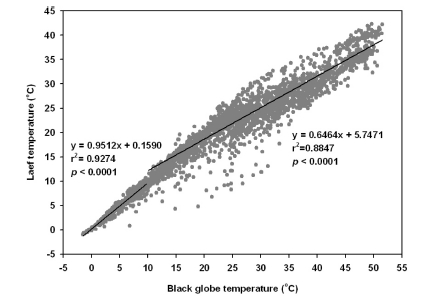
Relationship between black globe temperature and leaf temperature of C. officinale Makino.Coefficients of models and correlation between variables were calculated by linear regression analysis which were divided into 10 degrees or less and 10 degrees or more.
Jung 등 (2011)은 열환경 특성이 다른 지역에서 기온과 흑 구온도간 회귀분석을 실시한 결과 회귀식의 절편은 환경 중 복사에너지로부터 받는 영향의 크기를 나타내므로 주변의 복 사효과가 클수록 절편이 증가하고, 기울기는 온도의 영향을 나 타내는데 기울기가 클수록 온도변화에 민감하다고 하였다.
일출 전 또는 일몰 후 태양복사의 영향이 없을 때 대부분 흑구온도가 10℃ 이하였으며 태양복사의 유입이 많을 때 흑구 온도가 10℃ 이상을 나타내었으므로 태양복사가 없는 야간의 엽온은 주간에 비하여 기온변화에 1.47 배 정도 영향을 많이 받으며, 일출 이후 주간에는 태양복사, 토양 또는 피복자재 등 에서 발생되는 복사열의 영향이 36.1 배 높은 것으로 조사되 었다.
Hajizadeh 등 (2017)은 야외활동 시 발생되는 열 스트레스 평가를 위하여 흑구온도에 영향을 미치는 기상인자를 조사한 결과, 흑구온도의 변화는 주로 기온, 일사량과 높은 상관관계 를 보였으며 상관계수는 각각 0.63, 0.75를 나타내어 태양복사 에너지 유입이 흑구온도 상승에 큰 영향을 미치는 것으로 보 고하였다.
Turco 등 (2008)은 낮 동안 기온과 일사량의 흑구온도 변화 에 기여율은 87.7%로 나타나서 흑구온도는 기온과 태양복사 의 영향을 잘 반영하는 것으로 나타났다.
식물의 엽온은 일사에 의해 유입되는 열과 증산 등에 의해 잠열의 형태로 방출되는 비율에 따라 결정된다고 하였는데 (Park, 2011), 상록활엽수인 종가시나무 (Quercus glauca Thunb)와 낙엽활엽수인 고로쇠나무 (Acer mono Maxim)를 대 상으로 엽온을 관측한 결과 한낮에 최대 일사량은 976W/㎡ 일 때 직사광선을 직접 받는 상부에 위치한 잎의 온도는 40℃ 이상으로 관측되었으나 아래쪽의 그늘진 잎은 위쪽보다 엽온 이 낮았지만 바람이 불지 않아서 증발산에 대한 경계층 저항 이 큰 경우에는 잎의 위치에 따른 엽온 차이는 크지 않다고 하였다.
Fig. 1의 결과와 같이 흑구온도는 엽온에 대한 유의한 상관 을 나타내었으므로 기온과 복사에 의한 영향을 잘 반영할 수 있는 것으로 판단된다.
온도별 선형 회귀식을 이용하여 계산된 엽온과 실측치 간의 회귀분석을 실시한 결과, 모형의 기울기는 0.9430, 결정계수는 0.9500으로 매우 유의한 선형관계 (p < 0.0001)를 보여 개발된 모델식의 정확도가 높음을 알 수 있었다 (Fig. 2).
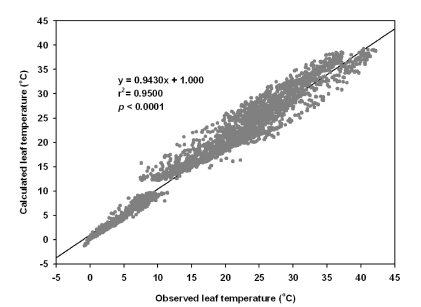
Relationship between observed leaf temperature and calculated leaf temperature of C. officinale Makino by linear regression equations of Fig. 1.Coefficients of models and correlation between variables were calculated by linear regression analysis which were divided into 10 degrees or less and 10 degrees or more.
2. 흑구온도와 기상요소의 관계
흑구온도 변화에 일사량이 미치는 영향을 분석한 결과는 Fig. 3과 같았다. 흑구온도에 기온 값을 빼면 복사에 의한 흑 구온도 변화에 대한 영향을 반영하므로 단파복사인 일사량과 의 결정계수는 0.8556, 기울기는 0.0168로 유의성이 높아서 일사에 의한 흑구온도 상승을 잘 설명하였으며 (p < 0.0001), 약 59.5W/㎡의 단파복사 유입은 흑구온도를 1℃ 상승시키는 것으로 분석되었다. 흑구표면에 영향을 미칠 수 있는 복사에 너지는 태양복사인 단파복사, 지면으로부터의 장파복사, 지면 과 식물체로부터 위쪽으로 향하는 적외방사 및 대기로부터의 적외방사가 영향을 미칠 수 있다.
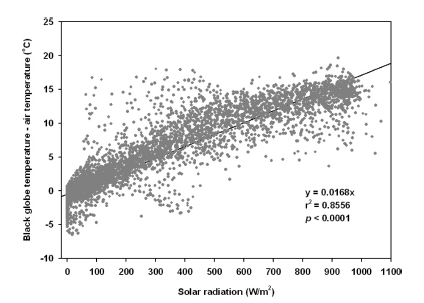
Influence of solar radiation on temperature rise in the black globe.The temperature rise in the black globe due to solar radiation was calculated by subtracting air temperature from the black globe temperature.
본 연구에서 단파복사가 흑구온도센서에 영향을 미치는 복 사의 효과를 분석하였을 때 매우 유의한 상관을 나타내었으므 로 태양 빛에 의한 단파복사 유입이 엽온의 변화에 유의한 영 향을 미치는 것으로 조사되었다.
흑구온도 변화에 대한 바람의 영향을 분석하기 위하여 풍속 과 복사에 의한 흑구 내 온도변화 간의 상관관계를 분석한 결 과 풍속이 커질수록 회귀모형의 기울기가 작아져 바람이 복사 의 영향을 감소시키는 것으로 조사되었다 (Table 1).
식물체를 포함한 물체의 표면에서 열 교환 반응은 잠열의 소실온도가 높은 곳에서 낮은 곳으로 반응이 진행되는데 식물 에서는 주로 잎의 기공을 통한 증산에 의하여 물을 대기중으 로 배출할 때 잠열소실에 의하여 잎의 온도가 낮아진다 (Park, 2011).
또한 식물이 증산과정에 있을 때 기공을 통해 나온 수증기 가 자유대기로 확산되는 과정에서 경계층 저항이 작용하지만 풍속이 일정 값 이상으로 크면 경계층 저항은 무시할 정도로 작아져서 증산에 미치는 기여도는 낮아지게 된다 (Collatz et al., 1991).
농경지에서 물의 증발량은 수증기압과 풍속에 영향을 받는 데 풍속이 0에 가까우면 수증기압 차이와 증발량의 기울기는 0.015를 나타내었으나 풍속이 2.6 m/s인 경우 기울기가 0.031 로 2 배 정도 증가하였다 (Han and Lee, 2005).
풍속의 평균 값과 풍속 구간별 회귀모형의 기울기에 대한 회귀분석을 실시하여 풍속이 흑구내 복사에너지에 미치는 영 향을 선형관계로 나타낸 결과는 Fig. 4와 같았으며 기울기는 -0.0032, 절편은 0.0208, 결정계수는 0.9707으로 매우 유의한 부의 상관을 나타내었다 (p < 0.0001).
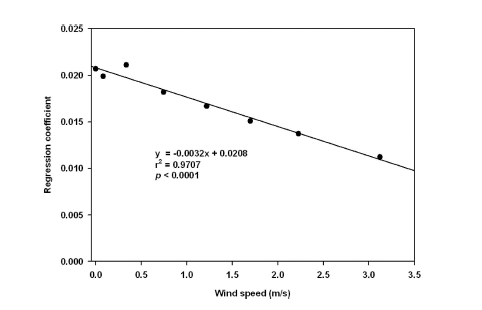
Influence of wind speed on coefficients of regression equations between wind speed and temperature change in black globe.The regression coefficients of y-axis means the regression coefficients of win speed section in Table 1.
따라서 풍속이 6.5 m/s 이상인 경우에는 복사에 의한 흑구 내 온도상승의 영향은 없어지는 것으로 분석되었으며 이와 같 은 결과로 미루어보면 식물 잎에서 증산작용으로 기공을 통하 여 배출되는 수증기에 의하여 잎의 온도가 하강하는 것과 같 이 흑구의 표면에서도 바람에 의한 잠열의 소산작용이 있는 것으로 나타나서 복사에 의한 에너지 유입과 바람에 의한 잠 열방출의 평가가 가능한 것으로 조사되었다.
풍속에 따른 기울기 값 대신 Fig. 4의 관계식을 이용하여 흑구온도 추정식을 만들면 다음의 식과 같다.
- TBG= Tair+ (0.0208 – 0.0032 ×WS) × SR
- TBG; 흑구온도 계산 값 (℃)
- Tair; 지상 1 m 높이의 기온 (℃)
- WS; 지상 1 m 높이의 풍속 (m/s)
- SR; 지상 1 m 높이의 일사량 (W/㎡)
상기 식에 의하여 온도, 풍속 및 일사량 자료를 이용하여 흑구온도를 계산하였으며 흑구온도 계산 값과 실제 관측값을 Fig. 5에 나타내었으며, 흑구온도 실측값과 위의 식에 의한 계 산 값은 결정계수 0.9710, 회귀식의 기울기는 0.9537로 매우 선형적인 관계를 보여 흑구온도 변화는 기온, 일사량, 풍속에 따라 결정되는 것을 알 수 있었다.
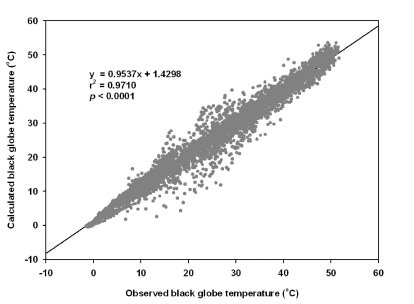
Relationship between observed black globe temperature and calculated black globe temperature.The regression equation for calculation of black globe temperature is expressed as air temperature + (0.0208 – 0.0032 × wind speed) × solar radiation.
따라서 Fig. 1에서처럼 흑구온도와 천궁 잎의 온도는 선형 적인 관계를 가지므로 상기 식의 내용과 같이 기온과 일사량 에 의해 직접적인 엽온 영향을 받았으며 바람에 의해서 엽온 의 하강이 이루어지는 것으로 조사되었다.
3. 저온기, 고온기의 흑구온도, 엽온 및 기온 관측
서리가 발생한 2018년 4월 24일부터 25일, 5월 3일부터 5 월 4일 아침까지 기온, 엽온 및 흑구온도 변화를 관측하였다 (Fig. 6).
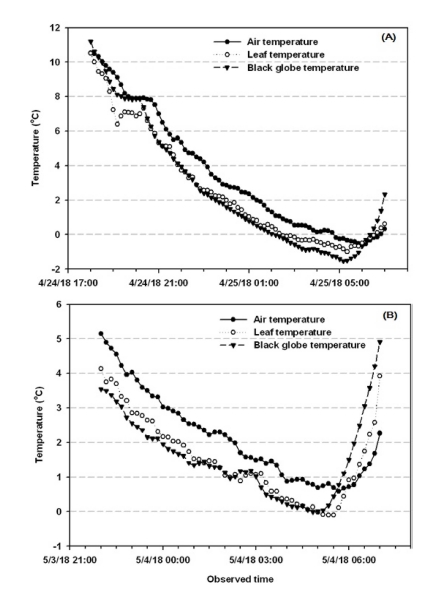
Comparing air temperature, leaf temperature and black globe temperature during frost occurrence.(A) temperature change from 24 April to 25 April 2018 and (B) from 3 May to 4 May 2018.
4월 24일 일몰 후 태양에 의한 복사유입이 없을 때 기온이 흑구온도와 엽온보다 다소 높게 나타났으며, 4월 25일 2시 10 분 경 흑구온도는 −0.03℃였으나 엽온은 2시 30분경 −0.06℃, 기온은 4시 50분 경 −0.17℃였고, 5월 4일 4시 50분경 흑구 온도는 –0.01℃였으나 엽온은 5시경 −0.03℃, 기온은 5시 40 분에 0.59℃로 관측되어 흑구온도의 온도하강 속도가 가장 빨 랐고 다음으로 엽온이었고 기온은 약 1℃ 정도 높게 관측이 되었다.
따라서 야간에는 기온 외에 장파복사에 의한 냉각효과 발생 등 엽온 감소에 대한 추가적인 연구가 수행이 되어야 할 것으 로 판단된다.
4월 25일 2시 16분의 엽온은 0.18℃에서 17 분 0.36℃, 20 분 0.31℃로 엽온이 약간 상승한 후 영하로 내려갔고, 5월 4 일 4시 53분에 0.19℃, 55분 0.27℃로 엽온이 약간 높아진 후 영하로 내려가는 현상을 보였다 (자료 미제시).
토양에서 온도변화는 직선적으로 하강하지 않고 일정하게 유지하다 하강하거나 반대로 온도가 상승하다 하강하는 현상 을 나타내었는데 이 현상은 대기중 물이 동결할 때 표면 온도 가 일시적으로 상승하는 것과 같이 토양수분의 동결잠열에 의 하여 온도가 일시적으로 상승한다고 하였다 (Lee, 1993).
따라서 본 연구에서도 천궁 잎의 온도가 영하로 내려가서 동결되기 전에 잠열변화에 따라 엽온이 일시적으로 상승을 한 것으로 판단된다.
고온기에는 일출 후 일사가 지표로 유입되면서 흑구온도가 가장 높게 올랐고 다음으로 엽온, 기온의 순으로 관측되었다 (Fig. 7).
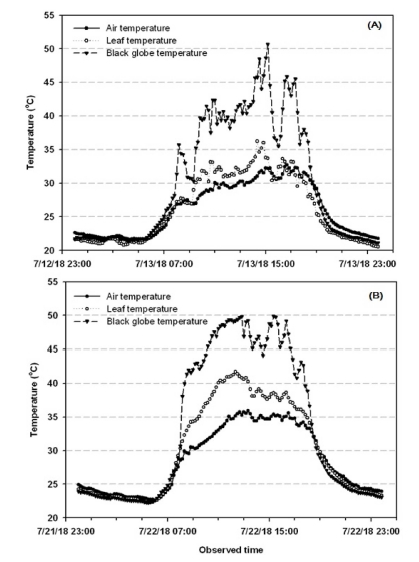
Comparing air temperature, leaf temperature and black globe temperature during hot weather conditions.(A) temperature change from 12 July to 13 July 2018 and (B) from 21 July to 22 July 2018.
흑구온도는 일사가 강해짐에 따라 온도가 급격히 상승하였 는데 7월 13일 15시 10분 경에 흑구온도는 50.7℃, 엽온은 33.7℃였지만 기온은 32.2℃로 엽온보다 낮게 나타났다. 7월 22일은 11시 40분부터 13시 20분까지 흑구온도는 49.1 - 49.9℃를 나타내었고 엽온은 40.9 - 41.7℃였으나 반면 기온은 34.5 - 35.9℃로 엽온에 비해 5℃ 정도 낮아서 일사에 의한 엽 온 상승의 영향이 매우 큰 것으로 조사되었다.
잎의 온도가 높고 대기온도 낮아서 수증기압의 차이 (vapor pressure deficit)가 클 때 잎의 수분포텐셜 감소로 두께가 얇아 져 수분장해를 받기 쉽고 (Syvertsen and Levy, 1982), 엽온 상 승에 따라 광합성율 감소, ribulose-1,5-bisphosphate carboxylase 와 fructose-1,6- bisphosphatase 등 광합성효소의 활성 저하, 3-phosphoglycerate, fructose-6-phosphate, glucose-6-phosphate와 같은 대사산물이 감소하는 것으로 보고하였다 (Kozba and Edwards, 1987).
더덕 재배 시 광포화점 이상의 조건에서 차광처리는 잎의 광합성율을 높이며 (Lee and Won, 2007) 삼채 재배 시 빛이 강할 때 55% 차광처리를 하면 잎의 호흡을 줄이고 광합성을 촉진시켜 생육과 수량을 높였다고 보고하였으므로 (Kim et al., 2017a), 저온 및 고온피해 예방뿐만 아니라 안정적인 재배 관리를 위하여 엽온을 정확하고 신속하게 관측은 매우 중요함 을 의미한다.
4. 천궁 생육과의 관계
7월 1일부터 24일까지 흑구온도와 천궁의 생육과의 관계를 조사하였다 (Fig. 8).
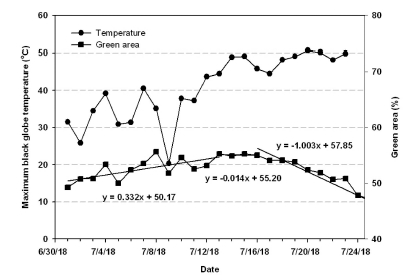
Changes in maximum black globe temperature and green area of C. officinale Makino during hot weather period.Maximum black globe temperature is the average value of 30 minutes before and after the peak time of day. Regression analysis is conducted on the change in the area corresponding to the green average value from July 1.
하루 중 최고 흑구온도 1 시간 평균값은 7월 11일까지 40℃ 이하를 나타내었으나 7월 12일 43.7℃에서 7월 15일 49.1℃로 지속적으로 상승하였고 7월 20일 50.7℃, 7월 21일 50.1℃로 고온과 강한 일사조건을 나타내었다. 천궁 군락의 녹색면적은 7월 13일까지 0.332의 기울기 값으로 증가하는 경향이었으나 7월 16일까지는 군락면적 증가가 없었고 7월 17일부터 −1.003 의 기울기 값으로 군락면적이 급격히 감소하였다.
생육조건이 비교적 양호한 7월 8일의 녹색면적은 52,778 pixel이었으나 생육 정지가 시작되는 7월 13일은 52,459 pixel 로 약간 감소하였으며 고사가 진행된 7월 22일에는 48,042 pixel로 조사되었다 (Fig. 9).
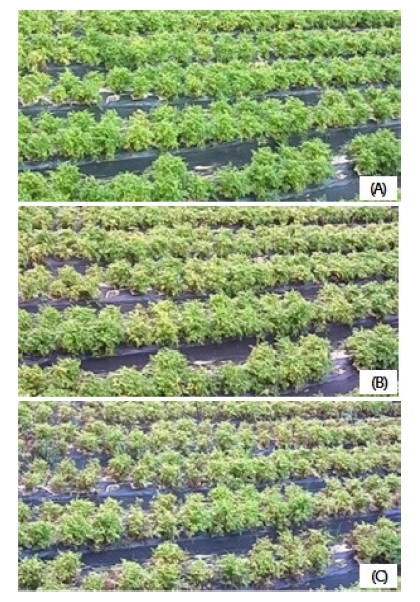
Change of canopy green area of C. officinale Makino during hot weather period.Canopy green area corresponding to the green average of 255 were 52,778 pixel at 8 July (A), 52,459 pixel at 13 July (B) and 48,042 pixel at 22 July (C).
그러므로 흑구온도가 45℃ 이상에서는 생육이 정지되므로 고사증상 방지를 위하여 임계 흑구온도는 45℃로 관리하는 것 이 적절한 것으로 판단된다. 따라서 개발된 모델을 활용한 흑 구온도의 관측은 엽온을 실시간으로 예측할 수 있을 뿐만 아 니라 잠열의 유입과 소산에 영향을 미치는 일사량, 바람의 영 향을 평가하는 유용한 방법인 것으로 사료된다.
감사의 글
본 연구는 농촌진흥청 지역특화작목기술개발사업 가뭄, 고 온장해 대응 천궁 안정생산 기술개발과제(과제번호: PJ012722) 의 지원에 의해 이루어진 결과로 이에 감사드립니다.
References
- Baek, IS, Park, CS, Park, CG, (2003), The effects ofCnidium officinaleextract on the ischemic stroke and oxidative neural damage in rat’ brain, Korean Journal of Herbology, 18, p37-46.
-
Blonder, B, Michaletz, ST, (2018), A model for leaf temperature decoupling from air temperature, Agricultural and Forest Meteorology, 262, p354-360.
[https://doi.org/10.1016/j.agrformet.2018.07.012]

- Choi, SY, Chang, KJ, Lee, KC, Park, CH, (2000), a Effects of planting density and rhizome weight on growth and yield of Ligusticum chuangxion Hort. andCnidium officinaleMakino, Korean Journal of Medicinal Crop Science, 8, p201-208.
- Choi, SY, Chang, KJ, Lee, KC, Park, CH, (2000), b Effects of mulching and shading on growth and yield of Ligusticum chuangxion Hort. andCnidium officinaleMakino, Korean Journal of Medicinal Crop Science, 8, p209-215.
-
Collatz, GJ, Ball, JT, Grivet, C, Berry, JA, (1991), Physiological and environmental regulation of stomatal conductance, photosynthesis and transpiration: A model that includes a laminar boundary layer, Agricultural and Forest Meteorology, 54, p107-136.
[https://doi.org/10.1016/0168-1923(91)90002-8]

-
Hajizadeh, R, Dehghan, SF, Golbabaei, F, Jafari, SM, Karajizadeh, M, (2017), Offering a model for estimating black globe temperature according to meteorological measurements, Meteorological Applications, 24, p303-307.
[https://doi.org/10.1002/met.1631]

- Han, JS, Lee, BY, (2005), Measurement and analysis of free water evaporation at Haenam paddy field, Korean Journal of Agricultural and Forest Meteorology, 7, p91-97.
-
Jeong, JB, Park, JH, Lee, HK, Ju, SY, Hong, SC, Lee, JR, Chung, GY, Lim, JH, Jeong, HJ, (2009), Protective effect of the extracts fromCnidium officinaleagainst oxidative damageinduced by hydrogen peroxide via antioxidant effect., Food andChemical Toxicology, 47, p525-529.
[https://doi.org/10.1016/j.fct.2008.11.039]

-
Jung, IS, Choi, DH, Lee, BY, (2011), Observational study of thermal characteristics by distribution ratio of green area at urban in summer season, Journal of the Korean Solar Energy Society, 31, p1598-6411.
[https://doi.org/10.7836/kses.2011.31.3.008]

- Kim, CG, Kang, BH, Kim, SD, Lee, SB, (1997), Effect of water stress on yield and quality ofLigusticum chuanxiongHort, Korean Journal of Medicinal Crop Science, 5, p1-6.
- Kim, JC, Jang, WC, Son, HR, Seo, YJ, Lee, JP, Park, HR, (2013), Medicinal plants in living, Daechangsa, Daegu, Korea, p360-361.
-
Kim, JM, Son, DW, Lee, PJ, Lee, KJ, Kim, HC, Kim, SY, (2003), Ethyl acetate soluble fraction ofCnidium officinaleMakino inhibits neuronal cell death by reduction of excessive nitric oxide production in lipopolysaccharide-treated rat hippocampal slice cultures and microglia cells, Journal of Pharmacological Science, 92, p74-78, 12832858.
[https://doi.org/10.1254/jphs.92.74]

- Kim, MH, Song, BM, Choi, EY, (2017), a Determination of growth, yield and carbohydrate content of Allium hookeri grown under shading treatment, Korean Journal of Medicinal Crop Science, 25, p397-403.
-
Kim, YI, Lee, SW, Kim, YJ, An, TJ, Kim, YG, Chang, JK, Kim, JW, (2017), b Effect of the establishment of cigarette beetle population on the quality of stored cnidium rhizome and angelica radix at room temperature, Korean Journal of Medicinal Crop Science, 25, p224-230.
[https://doi.org/10.7783/KJMCS.2017.25.4.224]

-
Kim, YI, Still, CJ, Roberts, DA, Goulden, ML, (2018), Thermal infrared imaging of conifer leaf temperatures: Comparison to thermocouple measurements and assessment of environmental influences, Agricultural and Forest Meteorology, 248, p361-371.
[https://doi.org/10.1016/j.agrformet.2017.10.010]

-
Kobza, J, Edwards, GE, (1987), Influences of leaf temperature on photosynthetic carbon metabolism in wheat, Plant physiology, 83, p69-74, 16665218.
[https://doi.org/10.1104/pp.83.1.69]

- Korea Meteorological Administration(KMA), (2018), Past data information system., Korea Meteorological Administration, http://www.weather.go.kr/weather/climate/past_cal.jsp (cited by 2018Oct 3).
- Lee, BY, (1993), A study on the effect of the latent heat in the soil., Ph. D. Thesis, Pusan National University, p12-28.
- Lee, CY, Won, JY, (2007), Effects of shading treatment onphotosynthetic rate and growth in Codonopsis lanceolataTrautv, Korean Journal of Medicinal Crop Science, 15, p152-156.
- Lee, JH, Choi, HS, Chung, MS, Lee, MS, (2002), Volatile flavor components and free radical scavenging activity ofCnidium officinale, Korean Journal of Food Science and Technology, 34, p330-338.
-
Michaletz, ST, Weiser, MD, McDowell, NG, Zhou, J, Kaspari, M, Helliker, BR, Enquist, BJ, (2016), The energetic and carbon economic origins of leaf thermoregulation., Nature Plants, 2, p16129, http://www.nature.com/natureplants cited by 2018 Oct 3).
[https://doi.org/10.1038/nplants.2016.129]

- Ministry of Agriculture Food and Rural Affairs(MAFRA), (2017), 2016 annual report of production for special purpose crops. Ministry of Agriculture, Food and Rural Affairs, Sejong. Korea, p86-91.
- Oh, YJ, Seo, HR, Choi, YM, Jung, DS, (2010), Evaluation of antioxidant activity of extracts from the aerial parts ofCnidium officinaleMakino, Korean Journal of Medicinal Crop Science, 18, p373-378.
- Ohk, HC, Lee, HS, Chae, YA, (1997), Factors influencing rooting and growth in stem-cut planting ofLigusticum chuanxiongHort, Korean Journal of Medicinal Crop Science, 5, p119-125.
- Park, CH, Lee, MS, Namkoong, SB, Yu, HS, Park, HW, (2004), Embryological characteristics on seed sterility ofLigusticum chuanxiongHort, Korean Journal of Medicinal Crop Science, 12, p209-213.
-
Park, JK, Jung, WS, Kim, SC, Park, GU, (2008), On the characteristics of globe temperature variation observed at downtown in summer season, Journal of the Environmental Sciences, 17, p907-918.
[https://doi.org/10.5322/jes.2008.17.8.907]

-
Park, YM, (2011), Leaf temperature characteristics being affected by light regimes, Journal of the Environmental Sciences, 20, p1599-1605.
[https://doi.org/10.5322/jes.2011.20.12.1599]

-
Syvertsen, JP, Levy, Y, (1982), Diurnal changes in citrus leaf thickness, leaf water potential and leaf to air temperature difference, Journal of Experimental Botany, 33, p783-789.
[https://doi.org/10.1093/jxb/33.4.783]

-
Turco, SHN, Silva, TGF, Olivera, GMD, Leitão, MMVBR, Moura, MSBD, Pinheiro, C, Padilha, CVDS, (2008), Estimating black globe temperature based on meteorological data., American Society of Agricultural and biological Engineers, https://elibrary.asabe.org/abstract.asp?aid=25593 (cited by 2018 Oct 3).
[https://doi.org/10.13031/2013.25593]

-
Um, JN, Min, JW, Joo, KS, Kang, HC, (2017), Antioxidant, anti-wrinkle activity and whitening effect of fermented mixture extracts of Angelica gigas, Paeonia lactiflora, Rhemannia chinensis andCnidium officinale, Korean Journal of Medicinal Crop Science, 25, p152-159.
[https://doi.org/10.7783/KJMCS.2017.25.3.152]

- Yu, HS, Bang, JK, Kim, YK, Lee, BH, (1999), Mass propagation by stem cutting inLigusticum chuanxiongHort, Korean Journal of Medicinal Crop Science, 7, p200-204.

